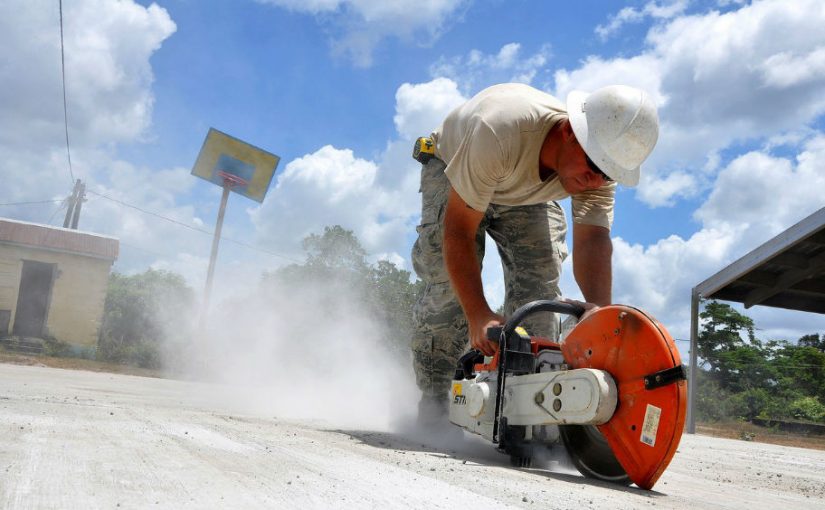Renovation and building projects offering involve some form or need for cutting concrete slabs. But what a lot of people might not appreciate or realise is that concrete cutting takes proper equipment, training and precise skill to do it well and to do it safely. That is why we strongly recommend it be left to professional concrete cutting services with the right machinery and background. There are various ways to cut concrete and different machines suit different tasks. There might be varied lengths and depths so a skilled hand is needed to get the exact size required.
Professional contractors could be a great alternative option to DIY
If you do decide on finding professional cutters vs concrete cutting DIY then look at local contractors that have the best equipment, have a good reputation and have done it all from cutting concrete slabs with a circular saw to all your other cutting needs. They have the experience whether you are cutting concrete floor, walls, to make room for doors and windows or so any other purpose. They know which cutting tools are best for each job too, from achieving deep or more subtle lines, straight or curved and so on.
How to cut concrete – Five ways to cut concrete safely and effectively
- Flush cutting – When you need to cut into a concrete floor and it has to be in a straight line then you need to do the flush cutting. The flush cutting saw can create a very precisely straight line when cutting reinforced concrete or regular concrete and used for brick cutting and stone cutting too. The flush cutting saw requires training but once you know how to use it is usually easy to maneuver. It is one of the smaller cutting tools so really suits incidences where the space you are cutting in is narrow or small, as the larger options cannot fit.
- Concrete hand sawing and Ring sawing – If you are looking for very precise cuts but ones that do not need to go that deep you might use a ring saw or hand saw. These are great for concrete cutting but also need training and to be used by people who know what they are doing. They are best for jobs like expansion joints, sawing walls and doorways and taking out concrete slabs and footpaths. They do not create a lot of debris in the worksite thanks to the water and dust system they have.
- High-Frequency and hydraulic sawing – Cutting concrete can be quite a disruptive and loud job. If you have concrete that needs cutting inside where the noise is especially bad you might want to look at professionals using high-frequency and hydraulic saws. It is also harder indoors to manage the dust and cleanup. As well as being less noisy options they are fume free making them safer for indoor jobs and they are easy to move around too.
- Floor or road sawing – When there is a large job to do for an outside project like road or floor cutting you need something precise that is able to cut down to the depth you need. Floor or road saws are specially designed to handle these requirements and professional cutters can cut to depths of 375 mm to 500 mm. Used on pavements, roads and asphalt, they can create the perfect cut with the right operator.
- Diamond concrete saw cutting – You can choose from two kinds of diamond cutting concrete saws, wet cutting saws and dry cutting saws. When looking at how to cut concrete you might use these to for several projects. The dry cutting diamond saw can get great results when you need to make cuts over and over in the same place to get deeper into the concrete. The wet cutting diamond saw uses water to prevent overheating, and that water also helps prevent dust dispersal so is also great for when you need a saw you can use continuously. They generate smooth and precise cuts with concrete.
Avoid Saw Blade Damage When Cutting
Concrete that has high aggregate and sand content wears more quickly than concrete with lower aggregate and sand. However, there’s techniques that can prolong the life of your concrete cutting blades, and things to avoid.
Never Use a wet blade dry. Water acts as a coolant to reduce friction and dust suppression. Blades that are not wet can overheat and become brittle from friction. A warped blade is going to ruin your cutting and poses a safety risk.
Choose the right concrete cutting blade. A butter knife is not used to cut steaks, so why use the wrong saw blade? Always use a quality diamond blade made for masonry cutting.
Don’t bury the blade. Pushing the blade down until the flange meets the cutting surface makes the saw work harder which could possibly cause the motor to burn out. you’re also likely to warp your blade from excessive temperature.
Safety Precautions While Cutting Concrete
Safety should always come first when dealing with such a heavy-duty task. Here are some safety measures to keep in mind:
Personal Protective Equipment (PPE). Always wear the right PPE when cutting concrete. This includes safety goggles, gloves, dust masks or respirators, and sturdy work boots.
Ventilation. If working indoors, ensure the area is well-ventilated, especially if using a dry-cutting method, to avoid inhaling harmful concrete dust.
Avoid Electrical Hazards. Make sure to locate and mark out underground utilities like electric lines and water pipes before cutting to avoid serious injuries.
Regular Maintenance. Ensure the cutting equipment is routinely checked and maintained for optimal and safe performance.
The Perfect Cut!
We hope these tips help you advance your concrete cutting project. Need help or have a large project? For cutting concrete in Melbourne our team of professional concrete cutters can get it done quickly, accurately and safely.
